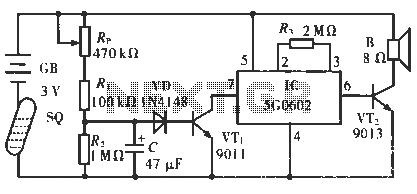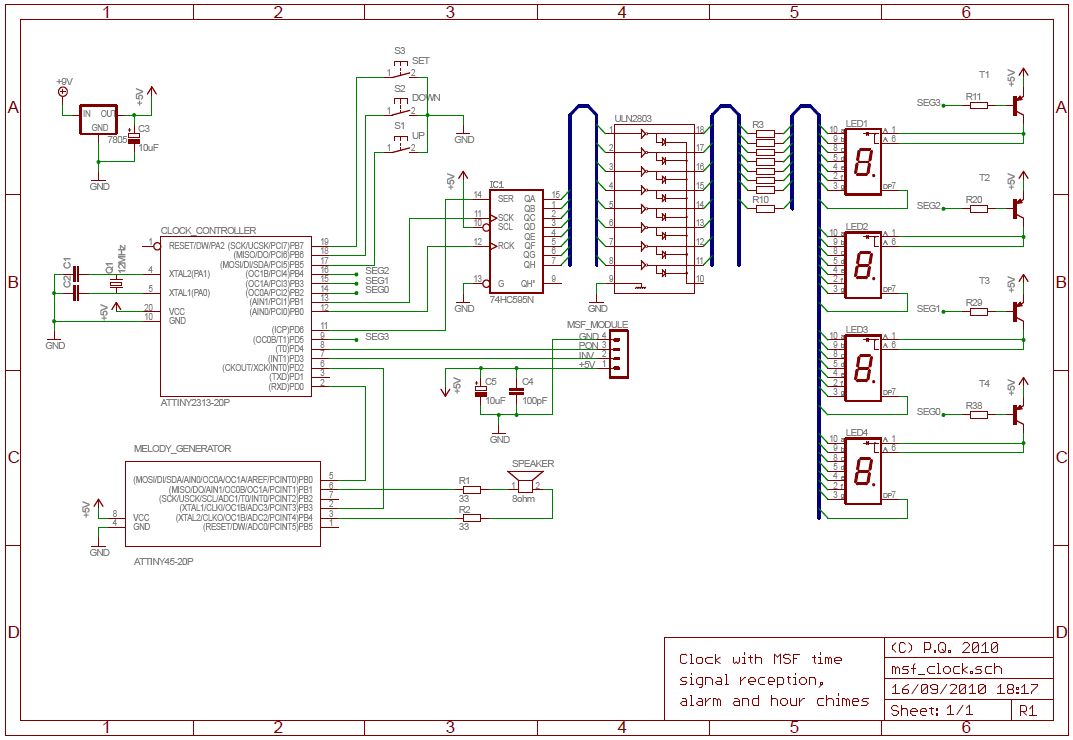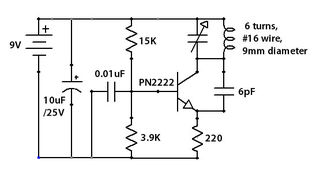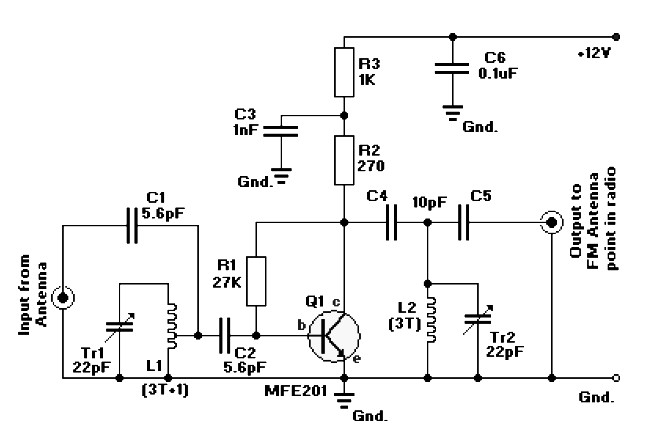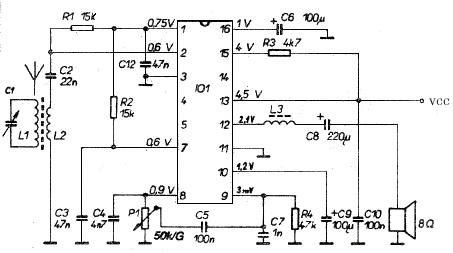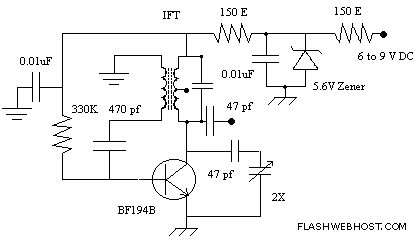
National Radio Institute (NRI) AM radio kit
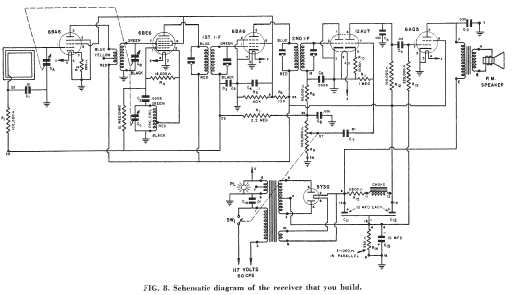
This National Radio Institute radio kit covers the AM broadcast band from 550 to 1700 KHz. The set was designed to be constructed as part of a radio course taught through NRI. Unlike some other correspondence course kits, it utilizes a safe transformer power supply. The tubes used include a 6BA6 RF amplifier, 6BE6 converter, 6BA6 IF amplifier, 12AU7 detector and first audio stage, 6AQ5 for audio output, and a 5Y3 rectifier. NRI was well-known for its electronic technician training programs. The institute also produced various kits, including test equipment and a simple Novice ham radio transmitter/receiver under the NRI and Conar labels. Upon inspection, the cabinet appeared to be a well-crafted homebrew design. However, after removing the chassis, a rubber stamp was found on the inside bottom, confirming it was an NRI-supplied cabinet available at an additional cost. The chassis contains IF transformers of differing sizes, several oversized resistors, and a 12AU7 dual triode used instead of the typical 6AV6 for the detector and audio preamp. It also includes a choke in the power supply as a partial PI filter, a negative power source for biasing the audio output tube, and three 1000-ohm resistors in parallel to develop that bias, among other unique features. Initial assumptions suggested that some components may have been substituted or miswired, particularly regarding the power choke; however, it was later confirmed that all unusual features were intentionally designed into the set. A paper copy of the 68-page NRI lesson set 7E1, titled "Practical Demonstrations of Radio-TV Fundamentals; Instructions for Experiments 61 to 70," was obtained, revealing that the unique parts were either repurposed from previous experiments or included for a series of tests conducted during the radio's assembly. These tests simulate induced faults, providing an excellent introduction to radio circuit faults and troubleshooting. The set functioned as received, although several capacitors in critical circuits were replaced for reliability. Alignment was found to be suspect, with a frequency counter indicating that the IF was aligned at 436 KHz instead of the required 456 KHz. It appears the builder lacked a proper signal generator for alignment, which is a common issue in such kits. The NRI lessons do cover alignment without a generator, but mistakes are frequently made. The pilot light is fixed into a grommet with a metal socket; to prevent short circuits from grommet failure, the connections were swapped to ensure the grounded side connected to the exterior metal of the lamp socket. The output transformer primary, which carries the full B+ voltage, had exposed solder terminals. Heat shrink tubing was added to mitigate the risk of high voltage exposure on the chassis. After approximately 45 minutes of operation, the power transformer was noted to be running slightly hot, drawing 0.48 Amps. Upon checking voltages and specifications, the power draw was determined to be normal for the design. However, to enhance safety given current power socket voltages, a choke for choke input and a 200-ohm resistor were added in the B+ circuit, reducing the power draw to 0.43 Amps, a 10% reduction. The maximum B+ voltage decreased from 345 volts to 309 volts, with the reduction having no adverse effect on radio performance aside from decreased heat generation. The NRI booklet states that when properly constructed and aligned, the radio performs comparably to higher-end commercial sets, which is indeed the case. The tuned RF stage, in conjunction with a standard superheterodyne configuration, effectively receives distant weak stations.This National Radio Institute radio kit covers the AM broadcast band from 550 to 1700 KHz. The set was designed to be constructed as part of a radio course taught through NRI. In contrast with some other correspondence course kits such as a later NRI chassis, it uses a safe transformer power supply. Tubes are a 6BA6 RF amp, 6BE6 converter, 6BA6 IF amp, 12AU7 detector and first audio, 6AQ5 audio out and 5Y3 rectifier. NRI was well-known as a correspondence school for electronic technician training. NRI also produced a line of kits such as test equipment and a simple Novice ham radio transmitter/ receiver under the NRI and Conar labels. I first thought the cabinet was an excellent home-brew job. After removing the chassis, I noticed a rubber stamp on the inside bottom of the cabinet. This was indeed an NRI-supplied cabinet which I am told was available at extra cost. The chassis has IF transformers of two different sizes, several large over-sized resistors, a 12AU7 (dual triode) in place of the usual 6AV6 for detector and audio preamp, a choke in the power supply as a partial PI filter, a negative power source for audio output tube bias, three 1000 ohm resistors in parallel to develop that bias, and some other unusual features.
I was wondering if someone had substituted components or simply miswired a couple of items such as the power choke. It turns out that ALL of the unusual features were designed into the set. I obtained a paper copy from George K. of the 68 page NRI lesson set 7E1 for this radio titled "Practical Demonstrations of Radio-TV Fundamentals; Instructions for Experiments 61 to 70".
The unusual parts were either recycled from previous experiments or were included for a series of tests conducted in the process of building the radio. The tests and experiments include a simulated series of induced faults that are an excellent introduction to radio circuit faults and troubleshooting.
This set worked as obtained. Even though most of the capacitors in the set were in good condition and did not need replacement, I replaced several caps in critical circuits. Like many radios built from a kit, alignment was suspect. A quick check with a frequency counter showed that the IF was aligned at 436 KHz rather than the required 456 KHz.
Apparently the builder did not have a proper signal generator for alignment. The NRI lessons cover alignment without such a generator, but alignment mistakes are common in these sets. The pilot light is fixed into a grommet using a metal socket. To prevent short circuits in the event of grommet failure, I swapped connections on the pilot light so that the grounded side was connected to the exterior metal of the lamp socket.
The output transformer primary which carries the full B+ voltage is exposed at its solder terminals. I added heat shrink tubing since I prefer not to have exposed high voltage on the top side of a radio chassis. The power transformer appeared to be running a bit hot after about 45 minutes. Power draw was 0. 48 Amp. After checking voltages and specifications, I determined that the power draw was normal for the design.
However, I was not comfortable leaving it that way given present day power socket voltages. I added a choke for choke input and a 200 ohm resistor in the B+ circuit. This reduced the power draw to 0. 43 Amp, about a 10% reduction. The maximum B+ is now 309 volts, down from 345. The reduction had no effect on the radio other than reducing heat build-up. The NRI booklet notes that the radio, when properly constructed and aligned is equal in performance to better commercial sets. It is indeed. The tuned RF stage with a standard superhet set performs quite well at pulling in distant weak stations.
The le 🔗 External reference
I was wondering if someone had substituted components or simply miswired a couple of items such as the power choke. It turns out that ALL of the unusual features were designed into the set. I obtained a paper copy from George K. of the 68 page NRI lesson set 7E1 for this radio titled "Practical Demonstrations of Radio-TV Fundamentals; Instructions for Experiments 61 to 70".
The unusual parts were either recycled from previous experiments or were included for a series of tests conducted in the process of building the radio. The tests and experiments include a simulated series of induced faults that are an excellent introduction to radio circuit faults and troubleshooting.
This set worked as obtained. Even though most of the capacitors in the set were in good condition and did not need replacement, I replaced several caps in critical circuits. Like many radios built from a kit, alignment was suspect. A quick check with a frequency counter showed that the IF was aligned at 436 KHz rather than the required 456 KHz.
Apparently the builder did not have a proper signal generator for alignment. The NRI lessons cover alignment without such a generator, but alignment mistakes are common in these sets. The pilot light is fixed into a grommet using a metal socket. To prevent short circuits in the event of grommet failure, I swapped connections on the pilot light so that the grounded side was connected to the exterior metal of the lamp socket.
The output transformer primary which carries the full B+ voltage is exposed at its solder terminals. I added heat shrink tubing since I prefer not to have exposed high voltage on the top side of a radio chassis. The power transformer appeared to be running a bit hot after about 45 minutes. Power draw was 0. 48 Amp. After checking voltages and specifications, I determined that the power draw was normal for the design.
However, I was not comfortable leaving it that way given present day power socket voltages. I added a choke for choke input and a 200 ohm resistor in the B+ circuit. This reduced the power draw to 0. 43 Amp, about a 10% reduction. The maximum B+ is now 309 volts, down from 345. The reduction had no effect on the radio other than reducing heat build-up. The NRI booklet notes that the radio, when properly constructed and aligned is equal in performance to better commercial sets. It is indeed. The tuned RF stage with a standard superhet set performs quite well at pulling in distant weak stations.
The le 🔗 External reference
